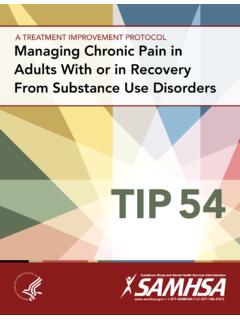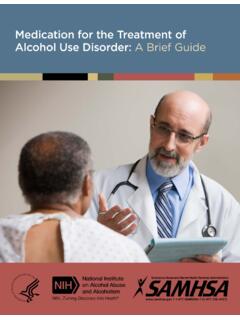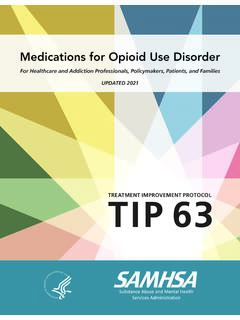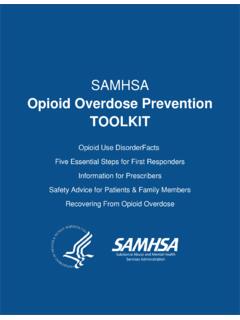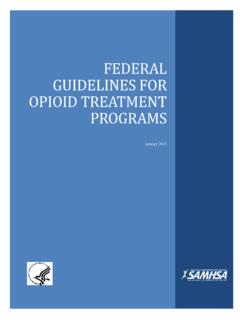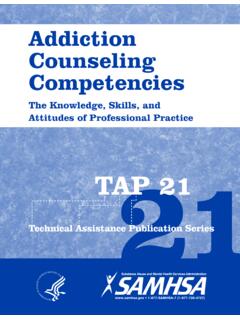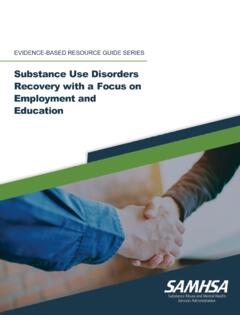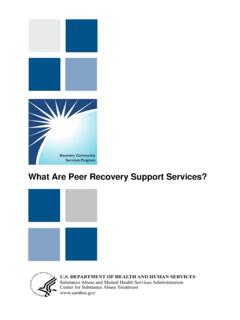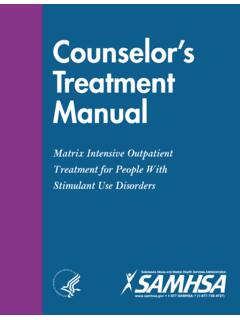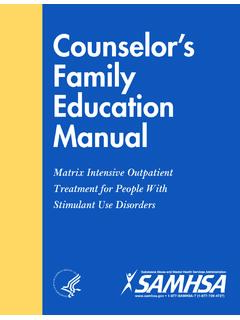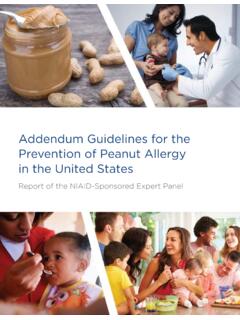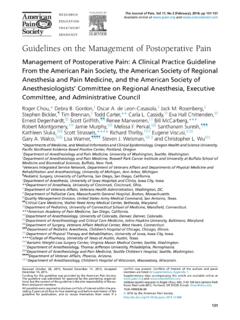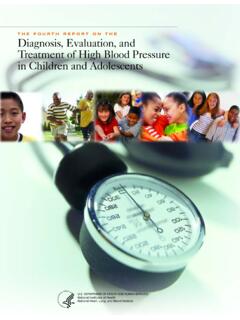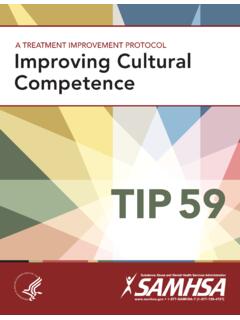Transcription of TIP 41 Substance Abuse Treatment: Group Therapy
1 Substance Abuse Treatment: Group TherapyA Treatment Improvement ProtocolTIP41 Substance Abuse Treatment: Group TherapyA Treatment Improvement Protocol TIP 41 DEPARTMENT OF HEALTH AND HUMAN SERVICES Substance Abuse and Mental Health Services Administration 1 Choke Cherry Road Rockville, MD 20857 AcknowledgmentsThis publication was produced under theKnowledge Application Program (KAP) contractnumber 270-99-7072 with the Substance Abuseand Mental Health Services Administration(SAMHSA), Department of Health andHuman Services (HHS). Karl D. White, ,and Andrea Kopstein, , , served asthe Center for Substance Abuse Treatment(CSAT) Government Project Officers.
2 ChristinaCurrier served as the CSAT TIPs Task opinions expressed herein are the viewsof the consensus panel members and do notnecessarily reflect the official position ofSAMHSA or HHS. No official support of orendorsement by SAMHSA or HHS for theseopinions or for the instruments or resourcesdescribed are intended or should be guidelines presented should not be con-sidered substitutes for individualized clientcare and treatment decisions. Public Domain NoticeAll materials appearing in this volume exceptthose taken directly from copyrighted sourcesare in the public domain and may be repro-duced or copied without permission fromSAMHSA or the authors.
3 Citation of thesource is appreciated. However, this publica-tion may not be reproduced or distributed fora fee without the specific, written authoriza-tion of the Office of Communications, SAMHSA, Access and Printed CopiesThis publication may be ordered from ordownloaded from SAMHSA s PublicationsOrdering Web page at , please call SAMHSA at 1-877-SAMHSA-7(1-877-726-4727) (English and Espa ol).Recommended CitationCenter for Substance Abuse Abuse Treatment: Group Improvement Protocol (TIP)Series, No. 41. HHS Publication No. (SMA)15-3991. Rockville, MD: Substance Abuseand Mental Health Services Administration, OfficeQuality Improvement and WorkforceDevelopment Branch, Division of ServicesImprovement, Center for Substance AbuseTreatment, Substance Abuse and MentalHealth Services Administration, 1 ChokeCherry Road, Rockville, MD Publication No.
4 (SMA) 15-3991 Printed 2005 Revised 2009, 2011, 2012, 2014, and 2015iiAcknowledgmentsContents What Is a TIP?..viiConsensus Expert Panel and Federal Government Participants ..xiForeword ..xiiiExecutive Summary ..xvChapter 1 Groups and Substance Abuse Treatment .. Introduction ..1 Defining Therapeutic Groups in Substance Abuse Treatment ..2 Advantages of Group Treatment ..3 Modifying Group Therapy To Treat Substance Approach of This TIP ..8 Chapter 2 Types of Groups Commonly Used in Substance Abuse Treatment ..9 Introduction ..9 Five Group Models ..12 Specialized Groups in Substance Abuse Chapter 3 Criteria for the Placement of Clients in.
5 37 Matching Clients With Groups ..37 Assessing Client Readiness for Group ..38 Primary Placement Considerations ..40 Stages of Recovery ..43 Placing Clients From Racial or Ethnic Minorities ..44 Diversity and Chapter 4 Group development and Phase-Specific Tasks ..59 Overview ..59 Fixed and Revolving Membership Groups ..59 Preparing for Client Participation in Phase Specific Group Tasks ..72 Chapter 5 Stages of Treatment ..79 Overview ..79 Adjustments To Make Treatment The Early Stage of Treatment ..80 The Middle Stage of Treatment ..85 The Late Stage of iii Chapter 6 Group Leadership, Concepts, and.
6 91 The Group Leader ..92 Concepts, Techniques, and Considerations ..105 Chapter 7 Training and Appendix A: Bibliography ..137 Appendix B: Adult Patient Placement C: Sample Group Agreement ..151 Appendix D: Glossary ..153 Appendix E: Association for Specialists in Group Work Best Practice Guidelines ..159 Appendix F: Resource Panel ..165 Appendix G: Cultural Competency and Diversity Network Participants ..167 Appendix H: Field I: Acknowledgments ..175 Index ..177 SAMHSA TIPs and Publications ..183 Contents iv Figures 1 1 Differences Between 12 Step Self Help Groups and Interpersonal Process Groups.
7 4 2 1 Groups Used in Substance Abuse Treatment and Their Relation to Six Group Models ..11 2 2 Characteristics of Five Group Models Used in Substance Abuse Treatment ..13 2 3 Group Vignette: Joe s Argument With His 2 4 Joe s Case in an Individually Focused Group ..27 2 5 Joe s Case in an Interpersonally Focused Group ..28 2 6 Joe s Case in a Group As A Whole Focused 2 7 The SageWind Model for Group 3 1 Eco Map ..38 3 2 Client Placement by Stage of Recovery ..43 3 3 Client Placement Based on Readiness for 3 4 What Is Culture? ..45 3 5 Diversity Wheel ..46 3 6 When Group Norms and Cultural Values Conflict.
8 48 3 7 Three Resources on Culture and Ethnicity ..48 3 8 Guidelines for Clinicians on Evaluating Bias and 3 9 Self Assessment Guide ..50 3 10 Preparing the Group for a New Member From a Racial/Ethnic 3 11 Culture and the Perception of Conflict ..57 4 1 Characteristics of Fixed and Revolving Membership 4 2 The Family Care Program of the Duke Addictions Program ..66 4 3 4 4 Examples of Agreements About Time and Attendance ..69 4 5 Examples of Agreements About Group 4 6 Reminders for Each Group Session ..74 6 1 Shame ..95 6 2 Confidentiality and 42 , Part 2 ..110 6 3 Jody s Arm.
9 121 7 1 How Important Is It for a Substance Abuse Group Leader To Be in Recovery?..126 7 2 Does Online Communication Impede Attachment? ..132 7 3 Group Experiential Training ..133 Contents v What Is a TIP?Treatment Improvement Protocols (TIPs) are developed by the Substance Abuse and Mental HealthServices Administration (SAMHSA) within the Department of Health and Human Services (HHS).Each TIP involves the development of topic-specific best-practice guidelines for the prevention and treat-ment of Substance use and mental disorders. TIPs draw on the experience and knowledge of clinical,research, and administrative experts of various forms of treatment and prevention.
10 TIPs are distributedto facilities and individuals across the country. Published TIPs can be accessed via the Internet each consensus-based TIP strives to include an evidence base for the practices it recommends,SAMHSA recognizes that behavioral health is continually evolving, and research frequently lags behindthe innovations pioneered in the field. A major goal of each TIP is to convey "front-line" informationquickly but responsibly. If research supports a particular approach, citations are provided. When nocitation is provided, the information is based on the collective clinical knowledge and experience of theconsensus panel.
